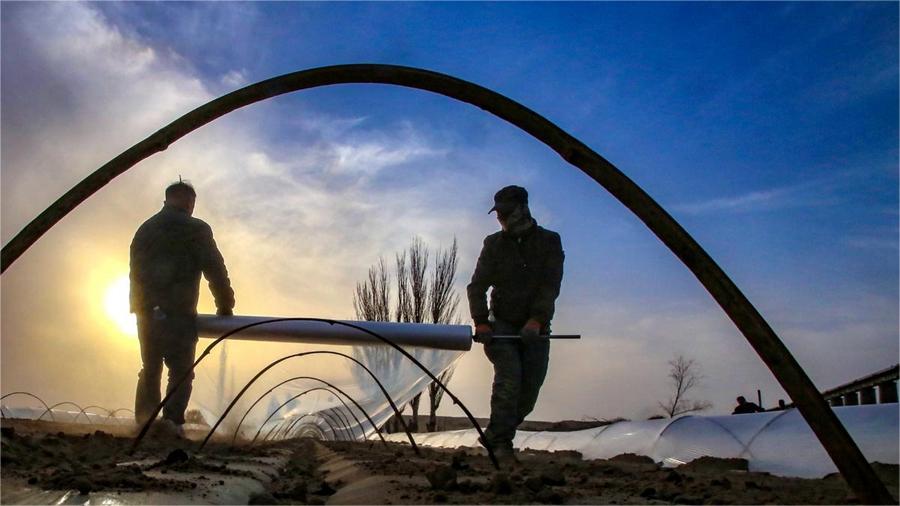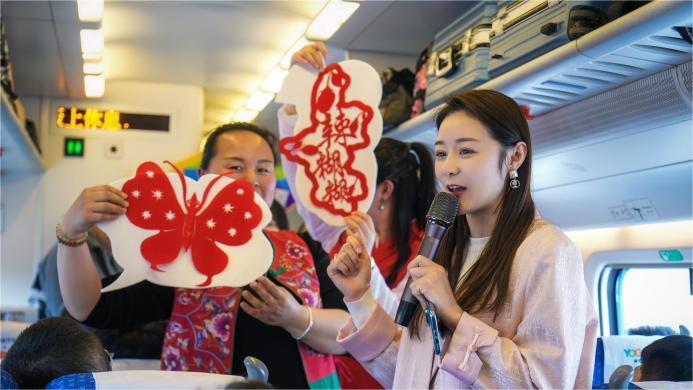Feature: Hungarian breathes life into cultural relics in China
SHANGHAI, March 29 (Xinhua) -- In 1988, Steven Back was amazed by the exhibition of terracotta warriors from China in his hometown Budapest, which was a cultural milestone marking the beginning of his lifelong pursuit of cultural exchanges.
Four decades later, the 44-year-old Hungarian museum professional and his team are working on another exhibition of the terracotta warriors in Hungary, which is their current big project.
As the representative of the Hungarian National Museum in China and the CEO of Back &Rosta, a company specializing in cultural digitization and intelligent museum solutions, Back has become a pivotal figure in museum digitalization -- dedicated to narrowing the gap between the past and the present and fostering understanding between China and Hungary.
Back's cultural journey began in the antique-filled rooms of his childhood home. His family's passion for collecting, particularly his father's interest in history, nurtured his fascination with the past and eventually led him across continents.
"I grew up surrounded by old books, old engravings and antiques," Back said. His fascination with China was further fueled by the 1987 exhibition of the terracotta warriors in Budapest, an event that captivated the Hungarian public and left an indelible impression on him.
With a master's degree in computer science obtained in Hungary and a PhD in social psychology acquired in the Netherlands, Back brings a unique blend of technical expertise and social insight to his work.
"When I was in the Netherlands, many exchange students from China wanted to go back to China after completing their studies," he told Xinhua at his office in Shanghai.
China's rapid development in the past decades brought huge opportunities to not only Chinese but also foreigners, attracting Back and others to pursue career opportunities in the largest developing country in the world.
When Back moved to Shanghai, hometown of his girlfriend and later wife, in 2005, he "was immediately impressed by the level of development in Shanghai," while adding that "skyscrapers were all over the city, which is quite different from European cities."
Back first worked in an investment bank, but a year later he switched to museum digitalization and, together with his friends, established his company's Shanghai branch.
In 2014, Back and his team launched "Magic Wall" technology, which combines high-resolution displays, advanced image rendering, and touch interactivity, bringing precious objects to life through multimedia, video guidance, and 3D models, thereby enhancing the visitor experience and educational impact. This innovative approach to combining computer science with museum exhibitions has proven to be a groundbreaking success, enhancing museum development and visitor engagement.
Today, this highly interactive high-tech technology is deployed in venues such as the Shanghai Science and Technology Museum, the Shanghai Museum, and the Pudong International Airport, which has woven a tapestry of technology and culture that bridges the chasm between centuries-old relics and modern viewers.
Since 2015, Back has been serving as the representative of the Hungarian National Museum in China, working to promote cultural exchanges between the Hungarian National Museum, the Shanghai Museum, and various provincial museums in China.
In 2017, he introduced the first large-scale exhibition jointly held by the Shanghai Museum and the Hungarian National Museum to China. This exhibition was titled "Sissi and Hungary: The Magnificent Life of Hungarian Aristocracy in the 17th to 19th Centuries." A total of 149 items were on display to give the Chinese public a taste of the reign of the House of Habsburg, one of the most influential royal houses in Hungary and Europe as a whole.
"I was impressed by the large number of visitors drawn by the exhibition. At that time, we didn't expect that Chinese audiences would be so interested in Hungarian culture," he said.
Last year, Back facilitated another exhibition, this time at the Mora Ferenc Museum in Hungary, which was co-hosted by the Shanghai Museum, the Xuzhou Museum and the Chengdu Institute of Archaeology, showcasing exquisite artifacts from the Chinese Han Dynasty, a period of cultural and economic prosperity in China.
Over 100 magnificent Han Dynasty relics were on display at this event, including the likes of jade, lacquerware, pottery, bronze, stone carvings, coins and more. According to official figures, these Chinese relics attracted nearly 70,000 visitors.
In Back's view, such cultural exchange events not only showcase the rich cultural heritage of both nations but also foster mutual understanding and friendship between peoples.
After nearly two decades of living in China, the Mandarin-speaking Hungarian has become a walking encyclopedia of Chinese museums, having visited over 1,000 of them across the nation. Some are in bustling metropolises, while others are located in small towns.
These experiences have given him a unique perspective on the rapid development of Chinese museums, particularly since the launch of the "Smart Museum" initiative in 2012, a testament to the country's commitment to preserving its rich cultural heritage through digital innovation.
"As China has placed more importance on building cultural confidence, we've seen more and more players involved in museum digitalization. We hope to introduce our innovations to more museums in China, even in village museums, by combining powerful visual experiences with highly efficient educational tools." Back expects that in the future, AI technology will further empower the digitalization of museums and set a new standard for cultural engagement.
"Among all the places I have been, Xi'an is one of my favorites. We are also planning to take the terracotta warriors from Xi'an to Hungary again as one of our big projects next year. The terracotta army is so popular that it is always successful wherever it goes," he noted.
Back's aspirations for the future align with the broader goals of the Belt and Road Initiative, which seeks to promote cultural and people-to-people communication among countries.
"We have been hugely successful in this market, and I consider myself very fortunate to have come to China at the right time," Back said.
"The country is growing in terms of infrastructure as well as services. My company is growing in terms of scale and industry-wide impact. It's as if our business is growing in tandem with the country at large," he added.
Photos
Related Stories
- China-funded railway draws students in Hungary
- Hungary, China jointly issue special stamps marking Year of the Dragon
- Xi congratulates Tamas Sulyok on election as Hungarian president
- Hungary's high-ranking official hails cooperation with China
- China's BYD to build new NEV factory in Hungary
- Hungary expects to enhance cooperation with China
Copyright © 2024 People's Daily Online. All Rights Reserved.









